“Avast there, ye swabs!”
Sure, there’re serious questions confronting the world, but one that is not
often mentioned, and then only below decks and in guarded whispers—
Is there really a good pirate movie out there?
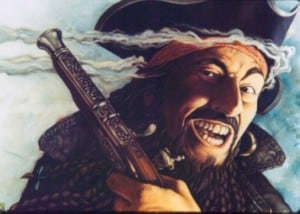 The meeker the man, the more pirate he.
The meeker the man, the more pirate he.
Snug in his armchair, far from the sea,
And reason commends his position:
He has all the fun and none of the woes,
Masters the ladies and scuttles his foes,
And cheats both the noose and perdition!
—The Armchair Pirate, anonymous
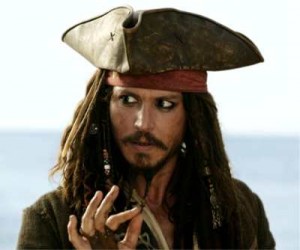 Most people don’t think of pirates as real people, do they? Not really, not as historical personages who actually existed; when it comes to movies, people envision pirates as caricatures, mostly for kids and certainly not to be taken seriously. Johnny Depp is the current vogue pirate, playing it for laughs with an effeminate touch, in the Pirates of the Caribbean series. There were the genuine pirates—and they weren’t nice people, blackhearts and scoundrels like Captain Kidd, Calico Jack Rackham, Sir Henry Morgan and, most famous, the notorious Blackbeard (Edward Teach), who owed loyalty to no man, not even his own crew.
Most people don’t think of pirates as real people, do they? Not really, not as historical personages who actually existed; when it comes to movies, people envision pirates as caricatures, mostly for kids and certainly not to be taken seriously. Johnny Depp is the current vogue pirate, playing it for laughs with an effeminate touch, in the Pirates of the Caribbean series. There were the genuine pirates—and they weren’t nice people, blackhearts and scoundrels like Captain Kidd, Calico Jack Rackham, Sir Henry Morgan and, most famous, the notorious Blackbeard (Edward Teach), who owed loyalty to no man, not even his own crew.
It’s been said that some people grow up, some just grow older. Well, I’ve certainly grown older—though I sometimes feel eighteen—but I’ve always felt there’re scraps and pieces of the child in me, as my continued love of pirate movies suggests. I would be tempted to say, so loyal am I to this genre, that even the most terrible pirate flick is endurable because there’re usually beautiful seascapes and always those gorgeous old sailing ships of the seventeenth and eighteenth centuries, sails billowing, leaning against the wind. For me, this affection is just another guilty pleasure, like eating unhealthy foods (ice cream, french fries and potato chips) or indulging bad art (romance novels and most vampire books). I’ll admit, though, there’s nothing worse than a terrible pirate movie—unless it’s a terrible horror movie.
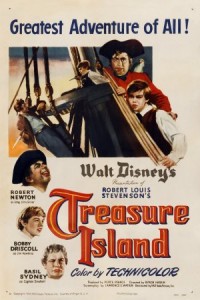 Which leads me to having seen for the first time Robert Newton in a 1956 TV episode of Alfred Hitchcock Presents, “The Derelicts.” A roll of his eyes and a quiver of a lower eyelid reminded me of his role as Long John Silver in Walt Disney’s Treasure Island (1950), and, though Robert Louis Stevenson’s story has been filmed as often as any book around, the Disney version remains the best of the lot. Through Long John, Newton became the proverbial pirate, with the famous trademark “ar-r-r-r—” that has become accepted as pirate talk.
Which leads me to having seen for the first time Robert Newton in a 1956 TV episode of Alfred Hitchcock Presents, “The Derelicts.” A roll of his eyes and a quiver of a lower eyelid reminded me of his role as Long John Silver in Walt Disney’s Treasure Island (1950), and, though Robert Louis Stevenson’s story has been filmed as often as any book around, the Disney version remains the best of the lot. Through Long John, Newton became the proverbial pirate, with the famous trademark “ar-r-r-r—” that has become accepted as pirate talk.
Many years before his Long John Silver fame, Newton possessed versions of those facial tics, but thereafter he exaggerated them into almost caricatures. The tics include a rolling of the eyes, a squint in one, a twitch in a lower eyelid and a glint of teeth; to boot, there is the speaking out of the side of his mouth and a sudden cock, sometimes a jerk, of his head.
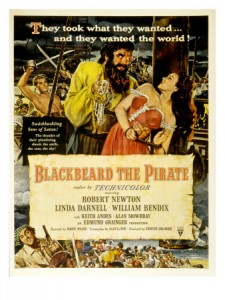 The little poem above follows the main title of RKO’s 1954 Blackbeard the Pirate. My initial impressions of the movie were immediate: brilliant Technicolor for the credits, set against a parchment scroll, and the music of Victor Young, with the poem accompanied by the jauntiest of tunes, perhaps not Young’s own, because it seems vaguely familiar. As best I recall, the melody is never heard again, unfortunately.
The little poem above follows the main title of RKO’s 1954 Blackbeard the Pirate. My initial impressions of the movie were immediate: brilliant Technicolor for the credits, set against a parchment scroll, and the music of Victor Young, with the poem accompanied by the jauntiest of tunes, perhaps not Young’s own, because it seems vaguely familiar. As best I recall, the melody is never heard again, unfortunately.
The director is first rate, although Raoul Walsh might not have owned up to his participation in this fun riot; he had earlier done another sea saga, Captain Horatio Hornblower with Gregory Peck, this from the Napoleonic era and a film of a much higher order.
As Blackbeard, Newton does an exaggeration of Long John Silver, creating an engrossing, if even hammier role; he has little bows in his beard but not the lighted matches on his hat that made the real pirate both famous and demonic. Newton provides some of the best lines, bouncing off dialogue from others—his witless first mate (William Bendix), an intoxicated Alvina (Irene Ryan of Beverly Hillbillies fame), even Edwina (Linda Darnell), who inspires the film’s best line, one the censors seemed to have overlooked. “My little robin redbreast,” Blackbeard calls her, with her low-neck red dress. Thereafter, by one and all, she’s usually referred to as “the little robin,” perhaps not wishing to test the censors too much.
The others in the serviceable cast include Torin Thatcher and Alan Mowbray, both experienced movie pirates. Keith Andes, as Edward Maynard, a spy who infiltrates Blackbeard’s crew posing as a surgeon, makes a poor leading man, even with his shirt off. There’re also Richard Egan in a throwaway role as Maynard’s friend and Skelton Knaggs as an emaciated crew member who hates his captain.
The plot is replete with things piratical: a fort attack, ship-to-ship combat, a mutinous crew and buried treasure—and as always with Blackbeard, a dead man must be buried with it. When Blackbeard is trapped on an island by Sir Henry Morgan (Thatcher), the pirate happens upon a crazy man with a similar beard. Blackbeard dresses the fellow in his clothes, then kills him. Sir Henry comes upon the corpse and cuts off the head as a trophy, which was part of the real pirate’s fate. When the movie Blackbeard is finally captured, he experiences a punishment common among the brethren of the coast, being buried up to his neck on a beach at low tide. The viewer almost feels sorry for the old scoundrel—much like another villain to come—as Edwina and Maynard sail off together.
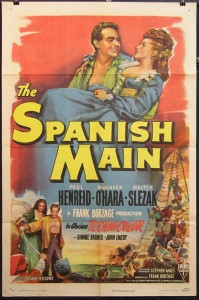 The Spanish Main (1945) is a better-than-you’d-think pirate yarn, mostly because of Maureen O’Hara, “the Technicolor girl,” as she was called, certainly not because of Paul Henreid. As a pirate he’s wooden, unathletic and decidedly unromantic, much as Roger Ebert described him in his excellent Casablanca commentary (an example, by the way, of what a great film commentary should be). Henreid delivers his lines with the conviction of a . . . well, of a Paul Henreid.
The Spanish Main (1945) is a better-than-you’d-think pirate yarn, mostly because of Maureen O’Hara, “the Technicolor girl,” as she was called, certainly not because of Paul Henreid. As a pirate he’s wooden, unathletic and decidedly unromantic, much as Roger Ebert described him in his excellent Casablanca commentary (an example, by the way, of what a great film commentary should be). Henreid delivers his lines with the conviction of a . . . well, of a Paul Henreid.
Binnie Barnes as Anne Bonney, albeit as a lady pirate, is a more convincing pirate than Henreid, but the real stealer of the show, once you dedazzle yourself from O’Hara, is Walter Slezak as the governor of Cartagena. While Newton achieves his ends with over acting and facial grimaces, Slezak makes his many good lines his own, tossing them off with nonchalant flair and a despicability that seems natural—a villain hard to hate. Even in the end, when he’s tied up on the poop deck of a ship, with death imminent, many viewers, I’m sure, feel just a tinge of empathy for him.
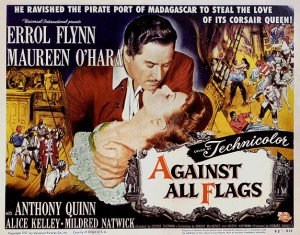 Another Maureen O’Hara pirate flick—maybe not the last?—is Against All Flags (1952). It has a few things going for it—cinematographer Russell Metty, stars Anthony Quinn, Mildred Natwick and the resonant-voiced Robert Warwick, besides O’Hara, of course. But it also has things going against it—Errol Flynn in his decline (not a happy sight against what had been), a weak script, lackluster action sequences and second string composer Hans J. Salter, not that a first-class score would have helped.
Another Maureen O’Hara pirate flick—maybe not the last?—is Against All Flags (1952). It has a few things going for it—cinematographer Russell Metty, stars Anthony Quinn, Mildred Natwick and the resonant-voiced Robert Warwick, besides O’Hara, of course. But it also has things going against it—Errol Flynn in his decline (not a happy sight against what had been), a weak script, lackluster action sequences and second string composer Hans J. Salter, not that a first-class score would have helped.